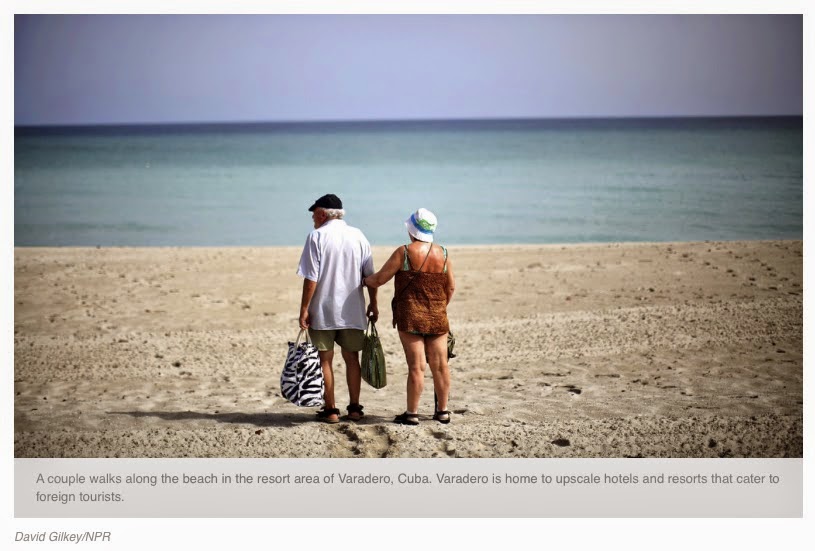by Greg Allen
Every day,
you can see signs of a subtle change in relations between Cuba and the U.S. at
Miami International Airport.
More Cubans than ever before are
coming to the U.S. to visit, and the number of Cuban-Americans traveling back
to the island is also at record levels. With all the visitors, money and goods
are now traveling to the island from the United States.
It's a legal loophole in the
50-year-old trade embargo — one that's having a real impact on Cuba's economy,
and allowing Cuban-Americans to become investors in Cuba's emerging private
sector.
'A Big Deal'
Shortly
after taking office, President Obama made it possible for more Americans than
ever before to travel to Cuba. He began by lifting restrictions on
Cuban-Americans. Before the change, they could travel to Cuba only once every
three years.
Last year, Cuba's government made
an even more unexpected move: It began allowing its citizens to visit the U.S.,
with few restrictions.
Now, eight or nine regularly
scheduled charter flights leave Miami daily for Havana and other Cuban cities.
At the airport, nearly everyone waiting in line is carrying packages and large
suitcases, even flat-screen TVs and other appliances.
Ana Dilla was waiting in line
recently with her two in-laws, who were returning home to Cuba after a short
visit. Their bags were full of goods they purchased to take home.
"Hair items, clothing,
shoes, hygiene items, makeup," Dilla says — all items that are hard to get
in Cuba.
Traveling from the U.S. to Cuba
is still a hassle. There are restrictions on the type of goods you can bring
and how much. Over a certain limit, and travelers pay a penalty. Cuba also
assesses customs duties on some goods.
But Dilla says the new freedom to
travel has made a big difference to her in-laws and others in Cuba.
"It was a big deal for them,
absolutely," she says. "It was much easier than in the past, so it's
a good thing. Things are getting a little bit better."
Because of the changes in
regulations in both countries, travel between the U.S. and Cuba is at record
levels — and growing. That includes so-called people-to-people travel, trips
that are organized by groups for education or cultural exchange.
But by far, most of the travel to
Cuba is by Cuban-Americans, and it's having an important economic impact on the
island.
"The presence of the
Cuban-Americans is just undeniable," says Joe Scarpaci, who heads the
Center for the Study of Cuban Culture and the Economy and has co-authored a
book on Cuba's emerging consumer culture.
Perhaps even more important than
their travel are the unrestricted remittances Cuban-Americans can now send back
to family on the island. Scarpaci estimates that goods and cash sent by
Cuban-Americans now is in the range of $5 billion a year, making it the
nation's second-largest source of income.
Using a Cuban slang term, he
calls it, "Gusanos carrying gusanos."
"Gusano is the
derogatory term that the folks of the island refer to when the Cubans left the
revolution — they crawled away from the glories of the revolution. Now they're
bringing back these duffel bags that are long and shaped like worms, or gusanos,"
Scarpaci says.
The goods carried in those
duffels aren't just clothing and cologne. Deep-fat fryers, power saws, electric
drills and soldering irons are in great demand in Cuba. Scarpaci says he knows
of many small businesses there that have started up with goods and cash
supplied by Cuban-Americans.
"From small restaurants to
home body repairs to plastic-mold makers for use of children's toys. In every
one of those instances, the capital for that has come from family members
abroad," he says.
Free Market Activity
Nearly 600,000 U.S. travelers —
mostly Cuban-Americans — visited Cuba last year. Polls show a majority of
Cuban-Americans now support unrestricted travel to Cuba. A majority also
believe Americans should be allowed to invest in Cuban businesses.
There are some, though, who
believe unrestricted family travel has led to abuses. Mauricio Claver-Carone is
the director of the U.S.-Cuba Democracy PAC, a lobbying group in Washington
that takes a hard line against any move to weaken sanctions on Cuba. While he
believes that taking a trip back to Cuba once a year to see family qualifies as
humanitarian travel, he says others are gaming the system.
"People that are going back
to Cuba more than once a year is not humanitarian. They're essentially residing
in Cuba. They have some type of business practice that they've established by
taking goods back and forth. They're called mulas," he says.
The Miami-to-Cuba
"mules" carry goods and cash, and, at least for some Cuban-Americans,
it's a legal end-run around the trade embargo.
"And essentially, they
charge per pound or they charge per package, things that they take to Cuba, so
they've established a business practice ... traveling to the island back and
forth," Claver-Carone says. "That is not the purpose of the
regulations. That's a business practice. And that should be illegal."
There are others, though, who say
this is the kind of thing unrestricted travel and remittances were intended to
accomplish. By traveling frequently to the island and helping — maybe even
investing in — businesses run by family members, Cuban-Americans are helping
spur the kind of free market activity long sought by the U.S.
Those who
favor engagement between the U.S. and Cuba say the next steps should include
lifting all restrictions on travel to the island and allowing U.S. visitors to
use credit cards there.









